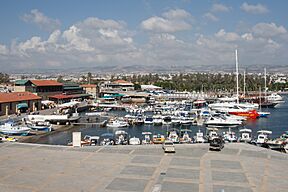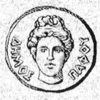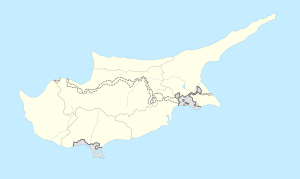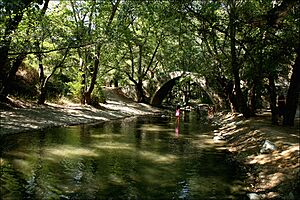Paphos facts for kids
Quick facts for kids
Paphos
|
||
|---|---|---|
|
City and municipality
|
||
|
Port of Paphos
Modern Aphrodite Sculpture
Paphos Castle
Municipal Library
Markideio Theatre
View of Paphos
|
||
|
||
| Country | ||
| District | Paphos District | |
| Elevation | 75 m (236 ft) | |
| Population
(2018)
|
||
| • City and municipality | 35,961 | |
| • Urban | 63,600 | |
| • District | 90,200 | |
| Demonym(s) | Pafitis, Baflı | |
| Time zone | UTC+2 (EET) | |
| • Summer (DST) | UTC+3 (EST) | |
| Post code |
8010-8049
|
|
| Area code | 26 | |
| Major airport(s) | Paphos International Airport | |
| UNESCO World Heritage Site | ||
| Criteria | Cultural: iii, vi | |
| Inscription | 1980 (4th Session) | |
| Area | 162.0171 ha | |
Paphos is a beautiful coastal city located in southwest Cyprus. It is the capital city of the Paphos District. Long ago, there were two places called Paphos: Old Paphos (now Kouklia) and New Paphos. Today, Paphos is the fourth-largest city in Cyprus. In 2018, about 63,600 people lived in its urban area.
The city of Paphos is right on the Mediterranean Sea. It's about 50 kilometers (31 miles) west of Limassol, which has the island's biggest port. The two cities are connected by a highway. Paphos International Airport is the second-largest airport in Cyprus. It helps people travel to western and southern parts of the island. Paphos has a warm, sunny climate, with mild temperatures all year round.
In 1980, UNESCO added Paphos to its World Heritage List. This was because of its amazing ancient buildings, colorful mosaics, and its importance in old religions. Paphos was also chosen as a European Capital of Culture in 2017, sharing the title with Aarhus in Denmark.
Contents
Understanding Paphos's History
How Paphos Got Its Name: The Myth of Aphrodite
The name Paphos comes from an old Greek story about the goddess Aphrodite. The myth says that Paphos was the son (or daughter, in some stories) of Pygmalion. Pygmalion was a sculptor who made a beautiful ivory statue of Aphrodite. The goddess brought the statue to life, and she became known as Galatea.
According to the story, Galatea and Pygmalion had a son named Paphos. Another legend says that Cinyras, who was either Paphos's son or Galatea's suitor, founded the city. He built a great temple there to honor Aphrodite. Another tale says the city was founded by Agapenor, a hero from the Trojan War.
Old Paphos: A Place of Worship
Old Paphos, now called Kouklia, sits on a hill east of the modern city. It was a very important center for the worship of Aphrodite. People believed that Aphrodite, the goddess of love and beauty, was born from the sea right near Paphos. This made Old Paphos the most famous place to worship Aphrodite in the ancient world.
Archaeological finds show that people lived in Old Paphos as far back as the Neolithic period (Stone Age). Cypriots honored a goddess of fertility even before the ancient Greeks arrived. The first temple structures were built in the Late Bronze Age. Worship continued there without interruption until 391 AD. At that time, the Roman Emperor Theodosius I made all pagan religions illegal, and the temple became ruins.
The priests of Aphrodite in Old Paphos were called the Cinyradae. They were very powerful. There was also an oracle here, where people could seek advice from the gods. Many poets wrote about the beauty and importance of Paphos. The huge ruins of Aphrodite's temple can still be seen today. After an earthquake destroyed it, the Roman Emperor Vespasian rebuilt it.
New Paphos: A City by the Sea
New Paphos was built on the coast, close to a natural harbor. It was about 12 kilometers (7.5 miles) northwest of Old Paphos. It also had a founding myth, saying it was built by Agapenor.
In reality, Nicocles, the last king of Old Paphos, probably founded New Paphos around 312 BC. He built a temple to Artemis Agrotera there. People from the city of Marion were likely moved to New Paphos after their city was destroyed. The oldest items found at the site are silver coins from the late 4th century BC.
Old Paphos remained the main place for Aphrodite worship. People would travel from New Paphos and other towns to visit the ancient shrine. The Roman Emperor Augustus helped rebuild Paphos after an earthquake. He called it "Augusta" in his honor, but the old name Paphos stuck.
Paphos in Early Christian Times
According to the Bible's Acts of the Apostles, the apostles Barnabas and Paul visited Paphos. They traveled across Cyprus, sharing the message of God. In Paphos, the Roman governor, Sergius Paulus, became a Christian after Paul spoke to him. This is also where Saul is first called Paul in the Bible.
The Roman historian Tacitus wrote that the young Titus visited Paphos before he became emperor. Titus was very interested in the city's history. He noted that the only image of the goddess in the temple was a pyramid-shaped stone. The temple was eventually closed when pagan religions were banned in the late Roman Empire.
Exploring Ancient Paphos
The Paphos Archaeological Park covers most of the ancient Greek and Roman city. It is a UNESCO World Heritage site because of its amazing ancient ruins.
Archaeologists have found four large and beautiful Roman villas here. These are the House of Dionysos, the House of Orpheus, the House of Aion, and the House of Theseus. All of them have well-preserved mosaic floors. Other discoveries include an ancient market (Agora), a healing center (Asklepion), the Basilica of Panagia Limeniotissa, a theater, and a burial ground called the Tombs of the Kings.
The mosaic floors in these wealthy Roman homes are some of the best in the Eastern Mediterranean. They show scenes from Greek mythology.
The city also has many catacomb sites from the early Christian period. The most famous is Saint Solomoni Church. It was originally a Christian catacomb and still has some 12th-century frescoes (wall paintings). There's a special tree at the entrance where people hang offerings. They believe it can cure illnesses.
A few miles outside the city, you can see the Rock of Aphrodite. This rock rises from the sea. Legend says that Aphrodite was born from the waves at this very spot. The Greek name, Petra tou Romiou, means "Stone of the Greek." It's linked to a legendary Byzantine hero, Digenis Acritas. He supposedly threw a huge rock at his enemies to defend the island.
Near Petra tou Romiou is Old Paphos, which was once a very important city-kingdom. The ruins of the Temple of Aphrodite are here. This temple was a major pilgrimage site until the 3rd or 4th century AD. A museum in the Lusignan Manor displays artifacts found in the area.
Yeroskipou, a town in the Paphos area, is famous for its 'loukoumi', a sweet Turkish delight.
North-east of Paphos is the Ayios Neophytos Monastery. It's known for its "Encleistra," a cave carved out of the mountain by a hermit. It has beautiful Byzantine frescoes from the 12th and 15th centuries.
The village of Lemba (Lempa), 4 kilometers (2.5 miles) north of Paphos, is home to many artists. You can visit their open studio shops. It also has a large sculpture called the Great Wall of Lempa and the Cyprus College of Art.
Off the coast of Paphos, you can see the wreck of the M/V Demetrios II. This ship ran aground in 1998 during a storm. Another shipwreck, the EDRO III, ran aground in 2011 near the Sea Caves of Paphos. Its cargo and fuel were removed, but the ship remains there. Local authorities are careful not to disturb the area, as it's a protected natural park where turtles nest.
Modern Paphos: A Tourist Destination
Paphos slowly became less important as an administrative center after Nicosia was founded. The city and its port continued to decline during the Middle Ages and under Ottoman rule. Nicosia and Larnaca became more important.
During the British colonial period, Paphos continued to lose people. Many moved to Limassol, Nicosia, or overseas. Paphos remained the least developed part of the island until 1974.
After the Turkish invasion of Cyprus in 1974, Paphos saw a lot of growth. The government invested in dams, roads, and building Paphos International Airport. This airport is the second international airport in Cyprus.
In the 1980s, the Kato Paphos area received most of the investment. Later, the Coral Bay Resort and the Aphrodite Hills resort were developed.
Today, Paphos has a population of about 35,961 (as of 2018). It is a very popular place for tourists. It also has a fishing harbor. Ktima is the main residential area. Kato Paphos, by the sea, has most of the luxury hotels and entertainment. Apostolou Pavlou Avenue is the busiest road in Paphos. It connects the city center to the medieval fort at the harbor.
Paphos's Economy
The economy of Paphos relies heavily on tourism. There are four main resorts in the district: Kato Paphos, Coral Bay, Latchi, and Aphrodite Hills. Kato Paphos is the largest resort and employs more than half of the city's population. Farming is also important to Paphos's economy. Farmers grow bananas, grapes, and tobacco.
Weather in Paphos
Paphos has a hot, dry climate. Summers are hot and dry, while winters are mild and wet. Most of the rain falls from November to mid-March. It almost never rains in July and August. Even in these dry months, the air can be quite humid.
Snowfall is very rare in Paphos, happening about once every 10 years. It usually doesn't cause much trouble. Snow falls almost every year in the hills of Tsada, which is 6 kilometers (3.7 miles) north of the city. The last time there was a lot of snow in the city center was in 2001.
Frost is also very uncommon.
Heatwaves are common in July and August. This happens when hot air from the Sahara desert moves over Cyprus. Cyprus has faced droughts in the past. Global warming might make these conditions worse. In 2008, Cyprus had to bring in water by ship from Greece. Since then, good winter rains have helped with the water supply.
| Climate data for Paphos (Paphos International Airport) (1991–2020) | |||||||||||||
|---|---|---|---|---|---|---|---|---|---|---|---|---|---|
| Month | Jan | Feb | Mar | Apr | May | Jun | Jul | Aug | Sep | Oct | Nov | Dec | Year |
| Record high °C (°F) | 24.0 (75.2) |
26.6 (79.9) |
30.8 (87.4) |
34.2 (93.6) |
42.5 (108.5) |
38.4 (101.1) |
41.6 (106.9) |
36.6 (97.9) |
36.2 (97.2) |
35.6 (96.1) |
31.6 (88.9) |
26.5 (79.7) |
42.5 (108.5) |
| Mean daily maximum °C (°F) | 17.3 (63.1) |
17.6 (63.7) |
19.2 (66.6) |
21.8 (71.2) |
24.9 (76.8) |
28.1 (82.6) |
30.4 (86.7) |
31.0 (87.8) |
29.4 (84.9) |
27.0 (80.6) |
23.1 (73.6) |
19.3 (66.7) |
24.1 (75.4) |
| Daily mean °C (°F) | 13.0 (55.4) |
13.1 (55.6) |
14.4 (57.9) |
16.8 (62.2) |
20.0 (68.0) |
23.3 (73.9) |
25.7 (78.3) |
26.4 (79.5) |
24.6 (76.3) |
22.1 (71.8) |
18.3 (64.9) |
14.9 (58.8) |
19.4 (66.9) |
| Mean daily minimum °C (°F) | 8.6 (47.5) |
8.5 (47.3) |
9.6 (49.3) |
11.9 (53.4) |
15.2 (59.4) |
18.5 (65.3) |
21.0 (69.8) |
21.7 (71.1) |
19.8 (67.6) |
17.2 (63.0) |
13.4 (56.1) |
10.4 (50.7) |
14.7 (58.5) |
| Record low °C (°F) | −1.5 (29.3) |
−3.6 (25.5) |
0.8 (33.4) |
1.6 (34.9) |
8.5 (47.3) |
10.5 (50.9) |
15.0 (59.0) |
17.0 (62.6) |
12.6 (54.7) |
9.6 (49.3) |
2.8 (37.0) |
−1.3 (29.7) |
−3.6 (25.5) |
| Average precipitation mm (inches) | 89.5 (3.52) |
60.1 (2.37) |
34.5 (1.36) |
15.2 (0.60) |
11.1 (0.44) |
1.6 (0.06) |
0.2 (0.01) |
0.1 (0.00) |
4.2 (0.17) |
21.7 (0.85) |
57.5 (2.26) |
97.6 (3.84) |
393.3 (15.48) |
| Average relative humidity (%) | 70 | 69 | 70 | 70 | 72 | 73 | 74 | 74 | 69 | 66 | 65 | 69 | 70 |
| Mean monthly sunshine hours | 180.1 | 191.2 | 245.5 | 277.9 | 336.6 | 371.8 | 381.6 | 355.0 | 312.3 | 278.3 | 219.7 | 181.0 | 3,331 |
| Source: NOAA | |||||||||||||
Getting Around Paphos
Public Transportation in Paphos
Buses in Paphos are run by a company called Osypa. For travel between cities, Intercity Buses offers daily connections to other cities in southern Cyprus.
The main bus station is Karavella station. It's a central hub for all intercity routes and many local routes. Another important bus station is the Kato Paphos Harbor station. It's located near Paphos Harbor and the Paphos Archaeological Park.
Roads and Motorways
Paphos didn't have a motorway until 2001. Now, it's connected to Limassol by the A6. There are plans for an A7 motorway from Paphos to Polis, and work on it is ongoing as of August 2023.
Paphos International Airport
Since 1982, air travel to and from Paphos has been handled by Paphos International Airport. It's located about 10 kilometers (6 miles) southeast of the city, near Timi. Around 1.75 million people use this airport every year. A new terminal opened in late 2008 next to the old one.
Paphos Port
The port in Paphos can hold 300 boats. It serves as a small marina and a safe place for fishing boats. The castle square at the port hosts the Aphrodite's festival every September. Many other yearly events, like the Paphos beer festival, also take place there. Large cargo and cruise ships use the Limassol Port, which is about 60 kilometers (37 miles) away. There are plans to build a new marina about 10 kilometers (6 miles) north of Paphos, near Coral Bay. This new marina will be able to hold up to 1,000 boats.
Healthcare in Paphos
Paphos has one main general hospital located in Anavargos, about 3 kilometers (1.9 miles) northeast of the city center. This modern hospital replaced an older one. There are also several private clinics in the area, like St George's Private Hospital.
Learning in Paphos
Schools in Paphos
The Paphos municipality has 38 primary state schools and 8 secondary state schools (called gymnasiums and lyceums). There are also 3 private English schools and one private Russian school. The first elementary school in Paphos was founded in 1796 in the village of Kritou Terra.
Higher Education in Paphos
Paphos has a higher education institute called Neapolis University Paphos. It started accepting students in June 2010. The university offers many different study programs for both undergraduate and postgraduate students. It has four schools. Soon, the American University of Beirut will also open a branch in Paphos.
Arts and Culture in Paphos
Paphos is famous for its cultural and historical sites. These include the Tomb of the Kings, beautiful Mosaics, the castle, and many churches. The city is also known for its festivals and yearly events.
Every September, Paphos hosts an annual opera as part of the Paphos' Aphrodite Festival at the harbor. The castle provides a stunning background for the performances. Another yearly event is Open Studios Cyprus, which takes place on certain weekends in October. During this event, artists open their studios to the public. This allows visitors to see their work and talk with them in a relaxed setting.
Paphos has several private art galleries and exhibition spaces. You can find information about regular events in local English newspapers. Palia Ilektriki is an exhibition and conference space run by the Paphos Municipality. This building, which used to be an electricity plant, hosts conferences and exhibitions all year.
In 2012, Paphos was chosen as the European Capital of Culture for 2017. This was a big opportunity for the city to grow and attract more tourists. Many improvements were made in the years leading up to 2017. The opening ceremony featured modern dance groups, the Music School of Pafos, and singer Alkistis Protopsalti. Throughout 2017, many cultural events took place, including a concert by the Berliner Philharmoniker and a performance by the Yamato Taiko Drum Ensemble. The program had many volunteers who helped make the events successful. After its closing ceremony in December 2017, Paphos passed the title to Valletta in Malta and Leeuwarden in the Netherlands.
Sports in Paphos
Paphos has a long history in sports, with several teams for football, basketball, and volleyball. The local gymnastic club is called Korivos. It owns the Pafiako Stadium and the Aphroditi Sports hall.
Stylianos Kyriakides (1910–1987) was a marathon runner from Statos, a village near Paphos. He won the 1946 Boston Marathon. A newspaper reported that an old man in the crowd shouted, "For Greece, for your children!" This inspired him to win the race.
Paphos was once home to the Turkish Cypriot sports team Baf Ülkü Yurdu. After conflicts and the Turkish invasion, the team moved to Morphou.
Famous People from Paphos
- Archbishop Makarios – The first President of the Republic of Cyprus.
- Rauf Denktaş – A Turkish-Cypriot politician.
- Marios Joannou Elia – A composer and artistic director.
- Theo Paphitis – A British-Cypriot businessman.
- Christos Shelis – A footballer.
Sister Cities
Paphos has sister city relationships with many cities around the world, including:
 Chania, Greece
Chania, Greece Kalamaria, Greece
Kalamaria, Greece Preveza, Greece
Preveza, Greece Lamia, Greece
Lamia, Greece Corfu, Greece (since 1992)
Corfu, Greece (since 1992) Mytilene, Greece
Mytilene, Greece Anzio, Italy
Anzio, Italy Florence, Italy
Florence, Italy Herzliya, Israel
Herzliya, Israel Košice, Slovakia
Košice, Slovakia Alexandria, Egypt
Alexandria, Egypt Liyang, China (since 2018)
Liyang, China (since 2018) Compton, United States (since 2018)
Compton, United States (since 2018)
Images for kids
See also
 In Spanish: Pafos para niños
In Spanish: Pafos para niños


























